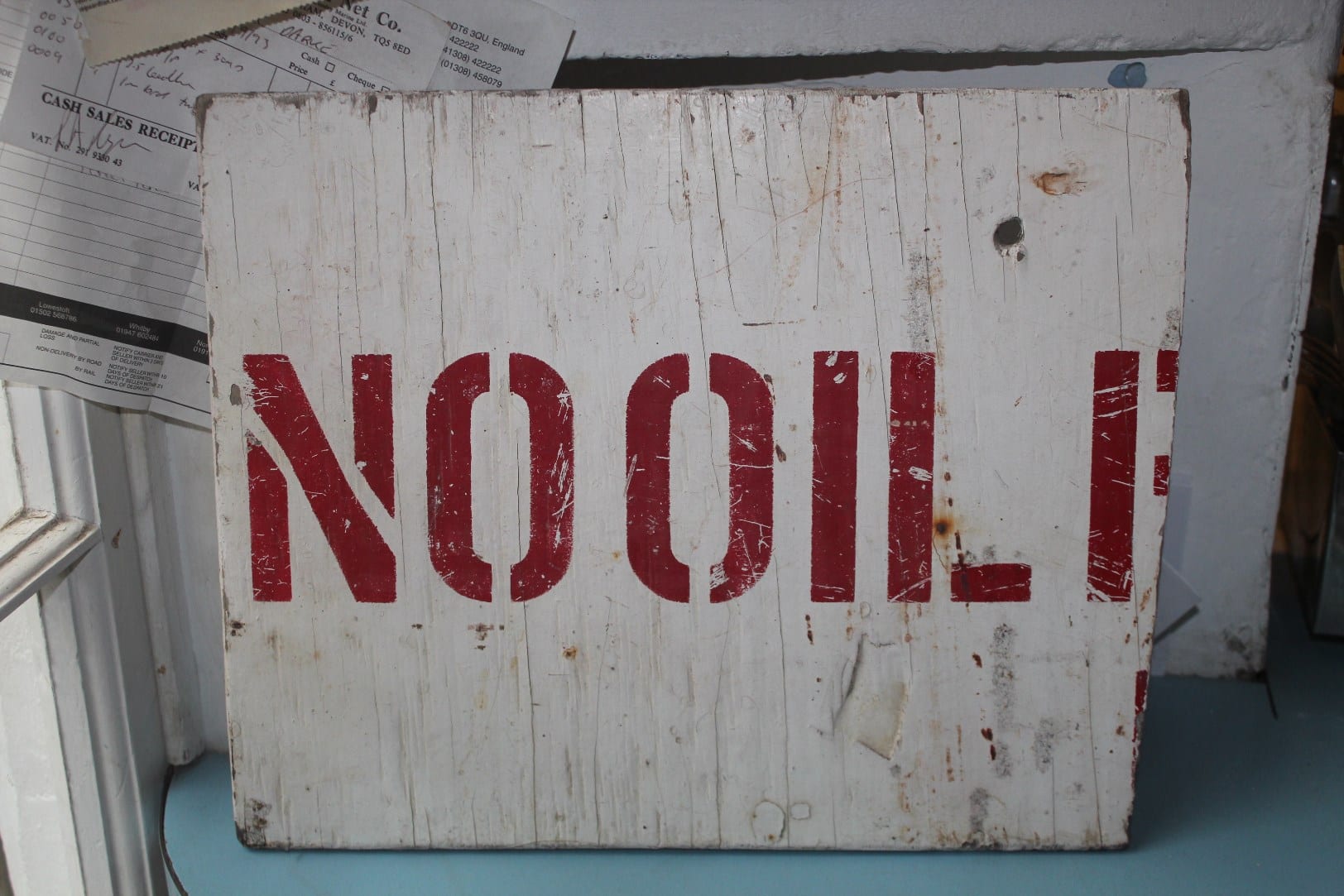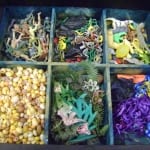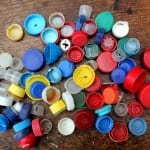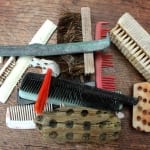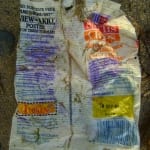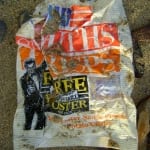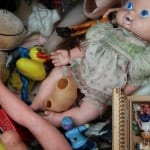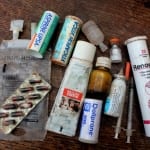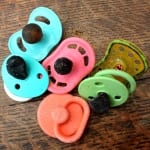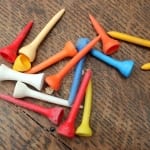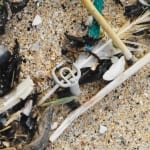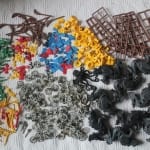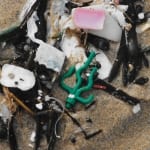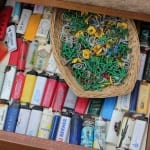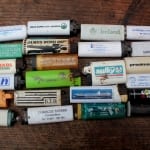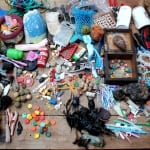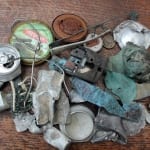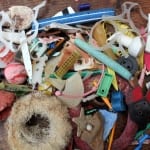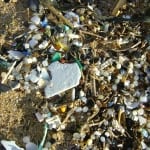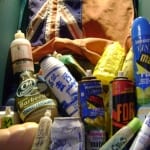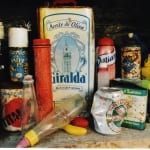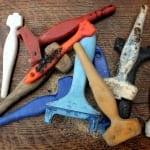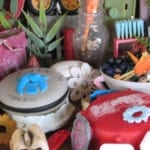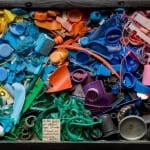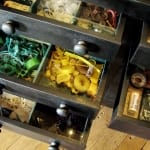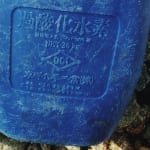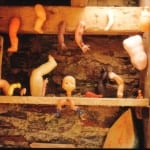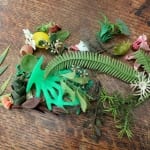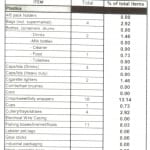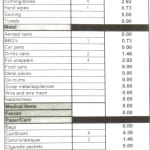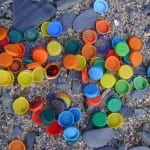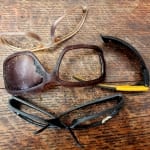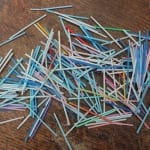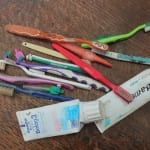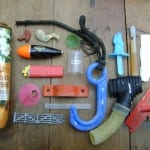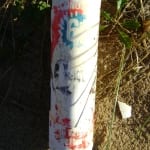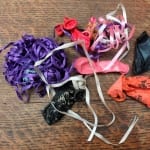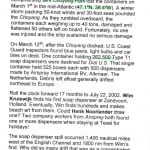A Sign
I found a sign on the beach today.
It says NO OIL in Red on white,
another word has been chopped off at the start,
half a P is left, it may be PLEASE.
The sign lay buried on a line of tide,
previous lines high up the beach
were defined by plastic which the sea spat out.
P for PLASTIC – raw unformed and plastic broken down.
P for POLLUTION.
Oiled birds caught in accidental harbour spills,
thin carcasses with feathers caste in black,
dead Fulmars with plastic in their gut.
P for POLYETHYLENE, POLYPROPYLENE, POLYSTYRENE
PIECES- sometimes eighteen in one bird,
that trickled down the gutters,
ditches, rivers to the sea.
P for PETROLIUM or PETRO CHEMICALS or PROPYLENE
to make PLASTIC breaking down to micro PARTICLES
eaten by worms in silt, eaten by tiny fish, eaten by bigger fish,
eaten by all fish eaters eaten by us,
now part of our bodies, floating in our blood,
and ocean currents of salt water
which connect the land
and on a beach ground down to sand.
P for P.E.B. or PLASTIC EATING BACTERIA
consuming POLYETHYLENE TEREPHTHALATE or P.E.T.
waiting quietly, evolving in chemical scum,
spreading through the waters of the world,
following the currents and the tides and eating as it goes
the plastic in the sea, in mud, in land fill,
the plastic in the food chain – to find us:
P for P.P.P. the PARTLY PLASTIC PEOPLE.
Plastic
It has been estimated that 100,000 animals a year die from plastic ingestion or entanglement. Albatross feed plastic to their chicks, 252 plastic pieces were found in the decaying body of one chick. The stomachs of dead sperm whales on North Sea coasts in 2016 contained plastic, including a 13 metre fishing net, car parts and a bucket.
Midway Atoll, which is only 2.4 square miles, and the surrounding small atolls and islands, sit in the centre of the North Pacific Basin, in the flow of the North Pacific Current which runs past the Philippines, Hong Kong and Japan, and up to Alaska. In 2016 debris gatherers working for NOAA the National Ocean and Atmospheric Administration of the United States collected in one month: 6,651 plastic fragments, 1,468 beverage bottles, 872 other bottles or containers, 4,457 bottle caps, 540 cigarette lighters, 1,654 small nets/fragments, 128 medium nets, 61 large nets, 1,855 plastic buoys, 813 foam buoys, 486 toothbrushes and other toiletry products, 207 plastic toys, 1,986 oyster spacers, 270 eel cone traps, 570 flip flops and shoes, 82 fisheries baskets, 68 umbrella handles, 54 pens, 62 hangers.
Gutters lead to streams, streams to rivers, rivers to the sea.
Cosmetic firms produce micro plastics for toothpaste and exfoliates, for skin. Synthetic fibres in clothes break down when washed, plastic dust is released will we wear clothing. Plastic ropes decay and fall apart. Fine granules are lost from industrial blasting and washing.
Raw plastic granules, made for vacuum formed plastic moulds, escape during transportation. Other granules, used in sewage treatment to increase the surface area exposed to air, escape in heavy rain and accidents.
Most plastic is lost and enters the sea during accidents, natural disasters, hurricanes, floods, storms, tsunami. Micro plastic concentrations at river mouths following storms in California have been shown to increase by a factor of 18:1.
Micro plastic distribution in all the seas of the world increases steadily with population growth and plastic use.
In this country we have rubbish collection, most countries don’t. In parts of Morocco for example if rubbish isn’t burnt it lies around and gets washed into the sea when the rains come. Here our rubbish has been going to landfill sites for a long time. Many of these sites are on low lying land such as Mucking Marshes at the mouth of the Thames estuary, which took most of London’s waste for decades. Fresh kills in New York did the same. These old sites close to the sea will one day be inundated as melt water from the ice sheets and the warming and expansion of the oceans cause sea level to rise. Salt water will flood over them, rereleasing plastic and other toxic pollutants.
All plastic sticks to other chemicals which have been flushed into streams, rivers and the sea from industrial processes. Any plastic eaten has the potential to contain: lead, cadmium, chromium, benzene, carbon tetrachloride, chloroform, dioxin, ethylene dibromide, polychlorinated biphenyls, trichloroethylene, vinyl chloride and aldicarb all of which are toxic to living organisms.
A whale will eat car parts and whole fishing nets. Birds feed on plastic; feed it to their chicks, both die of starvation. Turtles eat plastic bags which float like jelly fish. Animals get caught in debris and starve. Small fish seem to prefer the plastic particles, many less than 1mm, and eat them before their natural food.
All plastic breaks down with time, under the sun and in water, into smaller and smaller fragments. Plastic particles sitting in mud and silt and floating in suspension are eaten by worms, plankton, crustaceans and small fish which in turn are eaten by larger fish and then by us. The micro particles cross from the stomach to the bloodstream and become part of our bodies.
Flotsam beneath the Dunes
Published in Beachcombers Alert 2015
Thoughts on beach archaeology- Curt Ebbesmeyer
While I was attending the 19th annual Sea Bean Symposium in Cocoa Beach, Florida, Jane Darke initiated a fascinating email string concerning flotsam stored in the dunes and beneath rocks.
“I just listened to the radio piece about Lego on the beaches here,” emailed Jane [October 24, 2014] from Cornwall at the Atlantic Ocean entrance to the English Channel. “I thought that you might be interested in my observation that the Lego has most likely not been at sea since the container spill; it has been sitting in sand dunes and under stones and rocks on beaches. The debris we find on beaches changes with the years so old debris is recognizable if you have been gathering as long as I have.”
“For the last 15 years or so there have not been any really big westerlies and so not many big seas off the coast here. Some people have built beach restaurants further down the foreshore, closer to the water’s edge, because the sea has not swept in so far. The dunes all along the north coast of Cornwall have built higher and higher. On Porthcothan beach, where I live, they have almost tripled in height over the last 20 years. This winter many of the new buildings built close to the sea were damaged or washed away but the dunes provided a valuable sea defence for many communities like mine on the edge of the Atlantic.”
“The last really big seas were in the winters leading up to 2005 when we filmed The Wrecking Season. Then we found a huge number of seeds from the Americas- which I’m sure you remember. At the time Charles Nelson said that he thought that some of them had come out of the dunes. He had been gathering from beaches for longer than Nick and I. We were relatively new to the game then.”
“Most beaches in Cornwall are not cleaned during the autumn, winter and early spring. So winter debris has always been buried as the dunes build. This last winter the big seas sliced the front off the dunes and scoured out beaches. Porthcothan beach level is still 9 foot lower than at the end of 2013. The sand was held in suspension by the waves and taken out — dropped half a mile out in some cases— the plastic debris was released and being lighter it floated in.”
Most of the beachcombers here have not been doing it for very long so they are not familiar with old stuff from older spills. I worked as the beach cleaner on this beach for 16 years and have been searching the beaches here for 20 years now so I recognize things.”
“AND I have seen the same thing happen when staying on the East coast of the UK where the cliff edges are eroding all the time. There I found 40-year old potato chip packets that had been held in suspension in shingle banks. These were films of plastic that would not survive the decaying properties of direct sunlight- with the printing still intact- with the price 6d written on them- old pre -decimal currency. Its interesting that there leather sits around for years because the shingle is so free draining that it doesn’t rot.”
“In March [2014] on this beach I found those white plastic nozzles that were everywhere 15 years ago — do you remember? — the ground up car parts of Ford cars that came ashore when ‘The Mulheim’ ran aground off Lands End in 2002 and were buried for 12 years under slate stones on beaches 30 miles up the coast from where they went into the sea, the coloured tops from Smarties (a tube of sweets no longer made in the UK), plastic containers from suntan oil and washing up bottles with 20/30 year old packaging, many, many cotton bud sticks of which we have been seeing less and less in the last ten years. AND Lego pieces.”
“It’s interesting. There were a lot of people getting very excited from Surfers Against Sewage and other organizations here about the amount of debris washing up after the winters storms this year. When they saw the old debris they thought it had been washing around in the ocean for years but plastic which floats for a long time does not retain its color or the printed word and becomes sculpted by weather or abrasion from rocks etc. as you know.”
”Heavier debris does get stuck in amongst loose kelp on the sea bed close to shore. When we get a big kelp dump, usually after storms in May, when the kelp is young and has been growing fast so is easily ripped off the rocks in a big sea, there are particular things among it: metal – usually aluminum cans, occasionally copper from the keels of old ships, socks full of sand, lumps of lignum vitae from blocks used in the age of sail- which doesn’t float, and coal from steam ships.”
“Most of what was picked up on beaches early this year had been ashore for years — stored in the dunes and under stones — and its release gave us a second opportunity to pick it up.”
”In fact, I was amazed at how little new debris washed ashore last winter. Apart from the contents of a French fishing boat which ran aground half a mile from here and the beach was covered with fish boxes and fish and everything else a fishing boat holds! This may be because there are fewer boats in the Atlantic, less fishing, hardly any freighters, fewer but larger cruise ships. So less packaged waste and fishing gear. A friend on the South Coast of Cornwall says they have been getting a lot more debris over the last few Winters. So perhaps there has been a change? Is this because the Gulf Stream is flowing further South? More reasons to record what we find.
”I am wondering if most debris has always been distributed by natural disasters. I have been expecting debris from New York and New Jersey after Hurricane Sandy in 2012 but have not seen much other than the usual fisheries tags from the USA. Where did it go, the South Coast here, is it still travelling Columbus Gyre or did it end up in a sand dune on a beach in Ireland, Scotland or Norway?”
I find your observations especially fascinating, “ commented Joanna Atherton of Bedfordshire. “I think it accentuates the importance of those people who live at the frontier of the Atlantic Current, as it is you who walk the shore on a daily basis that will spot those subtle changes which are not always obvious when looking at statistical data. It is the empirical finds and observations which offer so much more.”
“My boyfriend is an academic who specializes in researching ponds and lakes and has a scientific approach (collecting cores, analysing pollen samples in the lab to construct environments of the past), yet he will always consider records kept by locals (be it a nature diary, local newsletter, personal account, etc), that is held in equal esteem if not higher than the scientific results, as it will always provide the personal insight, which you have demonstrated.”
“I think it takes a lifetime of observations to spot differences/anomalies. As Jane mentions, there have not been any significant westerly’s on the stretch of coast, and it takes a lifetime to recognize the slight differences in environment to understand the variations in context to interpret the strandline.”
“As an artist, all of your comments are insightful and I thank you for sharing them as they inform my work, especially given the narrative strands that can be considered. If these items have been lying in the sands, they could be read as a snapshot or unconscious deposit of an earlier moment in time.”
“Around our area of Cornwall (south east coast) we don’t have any dune systems at all. As Tracey Williams says, though much of this stuff may have been trapped under rocks that get shifted in strong seas.” writes Claire Wallerstein. “I think it would be absolutely wonderful to mark the 10th anniversary [2015] of The Wrecking Season in some way. That film has been so inspirational for so many of us, and it seems very fitting now that marine litter seems to be moving up the political and media agenda.”
“It’s ten years since my husband Nick died next year and ten years since we filmed The Wrecking Season,” Jane concluded. “I have been looking at beaches here and in other parts of the world during that time. Nick was the communicator and as you probably remember was always amazed, almost to the point of disbelief, by natural processes. I find that I am most interested in interpreting a beach these days — in reading what I see and find.”
“I found the first tags and most of the seeds and we searched together – not many realize that. I made the mistake of leaving myself out of the film. He was so much better at talking. As Nick wrote for the end of The Wrecking Season — ‘the sea is telling us something’. Nick wasn’t sure what it was the sea was saying but the answers are there.”


